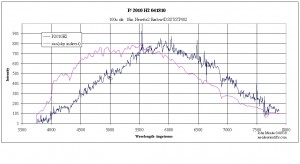Around April 15th this year, a mystery object in the inner solar system drew attention to itself by brightening from invisibility (to sky survey telescopes) such that it appeared as bright as a 12th magnitude star in a few hours. That is still much fainter than the eye can see without a telescope but it is a brightness increase of approximately 1,000 times!
It took a few days to work out the object is in an orbit circling the Sun located between Mars and Jupiter. After much discussion and many observations, the object has been classified as a comet and it now has the name Comet P/2010 H2 (VALES). Information on the observatory that found the comet can be found here.
I have been following observations about this comet. It fascinates me because it’s exact nature hasn’t been determined yet. It’s orbit isn’t particularly elongated like a comet yet it is behaving like one (a recent close up image of what looks like jets of dust coming of the nucleus can be found here).
What seems to be missing is the gas to make the dust come off the nucleus. John Menke (an amateur astronomer based in the US) has been kind enough to give me permission to reproduce a spectrum of the light from the comet he has produced using his telescope, as well as the email from him describing what it means.

His email is reproduced below.
Hello Paul,
I have attached an image of the spectrum, along with one of the sun (measured by sky/clouds reflection). The comet spectrum is clearly displaced to the red, presumably indicating that dust is the major source of the reflected light. The wiggles are really almost in the noise; however, it does look to me as though there are a substantial number of chemical lines present, but all are too small even to say for sure they are there.
I’ve done spectra for a dozen comets, and I’m no expert. However, from my experience, this is very similar to many other comets that show none or virtually none chemical signatures, but do show a red shifted spectrum from the sun.At this point, we cannot tell whether the object itself is a comet or asteroid–all we can see is a dust cloud around it that presumably could have come from either a comet or asteroid. The odds are that it is a comet–hard to see where all this fine dust would come from if it were an asteroid, say, that had a collision. Of course, if later spectra show chemical lines as many (not all) comets do, then the issue is decided.
Anyway, it is an interesting object, esp if it really has (like Holmes) burst forth into view!